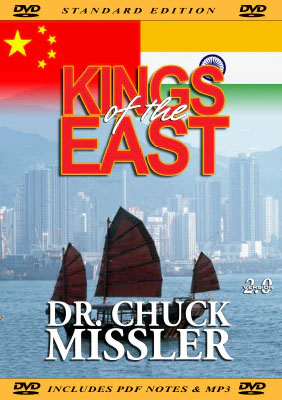As Bible students, we all are aware of the allusions to the "Kings of the East" in the prophetic scenario:
And the sixth angel poured out his vial upon the great river Euphrates; and the water thereof was dried up, that the way of the kings of the east might be prepared.
Revelation 16:12
In response, we all have become aware of the spectacular rise of China on the world scene. Just as Henry Luce dubbed the 20th century as "the American Century," many are recognizing that the 21st century will be "the Asian Century." And China's achievements are spectacular, indeed. In just one generation, they have tripled their per capita income, and lifted over 300 million people out of poverty! And they now have become the major competitor for energy and other commodities.
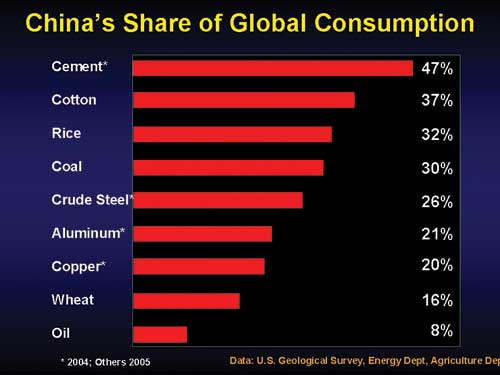
But with all of the spotlights singling out China, there is another - overlooked - giant rising in the east: India.
Few people realize the remarkable emergence of India in the global technological culture, which is destined to dominate the next few decades. Their research and development centers are sprouting everywhere and are the seedbeds of the most advanced software platforms, multimedia devices, and other next-generation innovations.
Major companies, such as Motorola, Hewlett-Packard, and Cisco Systems, are looking to laboratories in India for their most advanced product developments. Their advanced 3-D computer simulations are tweaking designs for car engines and aircraft wings for clients like General Motors and Boeing. India's Bangalore Research Hub is spawning companies that produce their own chip designs, software, and pharmaceuticals.
Daniel Sheinman, Cisco Systems' senior vice president for corporate development, declares, "We came to India for the costs, we stayed for the quality, and we're now investing for the innovation."
Just as China has emerged as a mass manufacturer, India is emerging as a giant in services. Technical and managerial strengths in both China and India are becoming more important that cheap assembly labor. And, their relative strengths are complementary, not competitive.
For example, China has excelled in mass manufacturing, with multi-billion electronics and heavy industrial plants; India has specialized in software, design, services, and precision industry. Their efficiency in back-office processing alone is legendary and outsourcing such work is expected to quadruple by 2010 to over $56 billion per year!
These two emerging giants will transform the entire global economy. China and India account for one-third of the world's population. For the past two decades, China has been growing at 9.5% per year, and India at 6% per year. Both are projected to continue at an annual rate of 7-8% for at least the next ten years. This is, in some ways, analogous to 19th century America, when a young, driven workforce grabbed the lead in agriculture, apparel, and the high-tech innovations of that era: steam engines, the telegraph, and electric lights. Similarly, these two emerging giants are positioning themselves at the vanguard of the critical technologies of the coming decades.
Tools For Growth
China's passenger car market in 2005 will reach three million per year (#3 in the world). It is this emergent transportation market that is already stretching the supply of oil on the world scene. Goldman Sachs is predicting $105/barrel on the horizon, as you may recall from our article in last month's edition of Personal UPDATE.
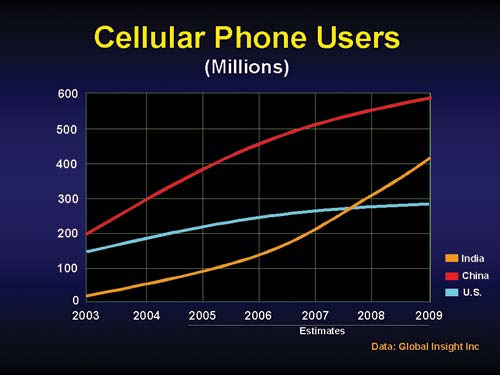 China now has the world's largest base of cellular phone subscribers: 350 million! They are expected to reach 600 million by 2009. India, too, has rocketed from 5.6 million to 55 million since 2000. China is expected to overtake the U.S. in homes connected to broadband in two years, and it will remain the manufacturing giant, but India will soar in technology and services.
China now has the world's largest base of cellular phone subscribers: 350 million! They are expected to reach 600 million by 2009. India, too, has rocketed from 5.6 million to 55 million since 2000. China is expected to overtake the U.S. in homes connected to broadband in two years, and it will remain the manufacturing giant, but India will soar in technology and services.
Yet, two-thirds of China's 13,000 listed companies don't earn back their true cost of capital. India, by contrast, has had to develop with scarcity. India also has Western institutions, a modern stock market, and private banks and corporations. They posted an average of 16.7% return on capital in 2004 (vs. 12.8% in China). In addition, India's banks are in much better shape. Over 20% of Chinas bank loans are bad. However, China has lured more foreign investment and so China has surged ahead of India in per capita GDP.
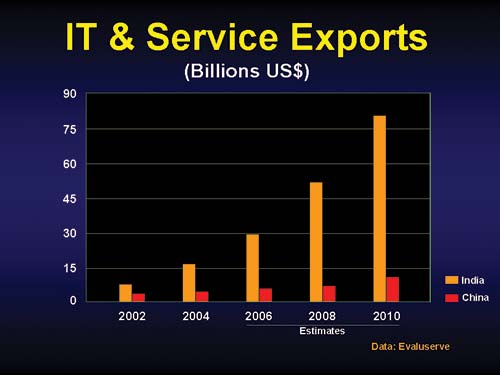 But India's younger workforce will give it a chance to catch up. Due to its one-child policy, Chinas working age population will peak at 1 billion in 2015 and then shrink steadily.) India has nearly 500 million people (twice the population of the U.S.) under the age of 19 and higher fertility rates. By mid-century, India is expected to have 1.6 billion people, 220 million more workers than China.
But India's younger workforce will give it a chance to catch up. Due to its one-child policy, Chinas working age population will peak at 1 billion in 2015 and then shrink steadily.) India has nearly 500 million people (twice the population of the U.S.) under the age of 19 and higher fertility rates. By mid-century, India is expected to have 1.6 billion people, 220 million more workers than China.
Caveats
There are some ominous factors that will challenge the management of the potential growth ahead:
- One million premature deaths in China and India attributed to air pollution;
- 30 million are projected to be infected by HIV/AIDS by 2010.
- 203 million workers without full time employment: 9.2% unemployment in India; 20% unemployment in China.
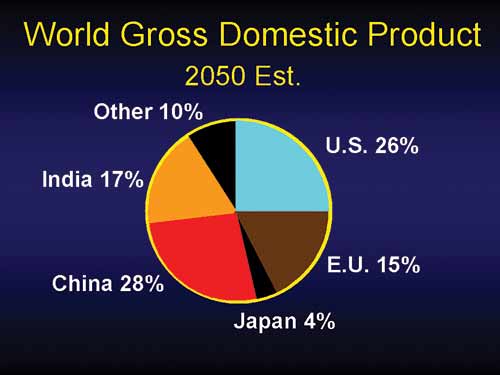 Each of these is a serious management challenge and a serious source of instability. But, barring any cataclysms, within three decades India should pass Germany as the worlds third largest economy. By mid-century, China should overtake the U.S. as #1. Together, China and India could account for almost half of the total global output!
Each of these is a serious management challenge and a serious source of instability. But, barring any cataclysms, within three decades India should pass Germany as the worlds third largest economy. By mid-century, China should overtake the U.S. as #1. Together, China and India could account for almost half of the total global output!
In considering the growth projections for Asia, it is also sobering to reconsider the optimistic projections for the United States. For instance, most of the U.S. projections ignore such factors as the killing of one out of every four babies who otherwise would have entered the workforce. (Since Roe vs. Wade, out of 127 million births, 48 million were murdered.) Also, serious challenges lie ahead to maintain global market share under the increased competition in technology, education, and other factors.
The commitment to education in both China and India dramatically overshadows the development of young professionals being produced in the U.S.
We will review more of these developments in our upcoming briefing package, The Rise of the Kings of the East. We should all aspire to be like the sons of Issachar, who understood the times and knew what they had to do (1 Chr 12:32).






